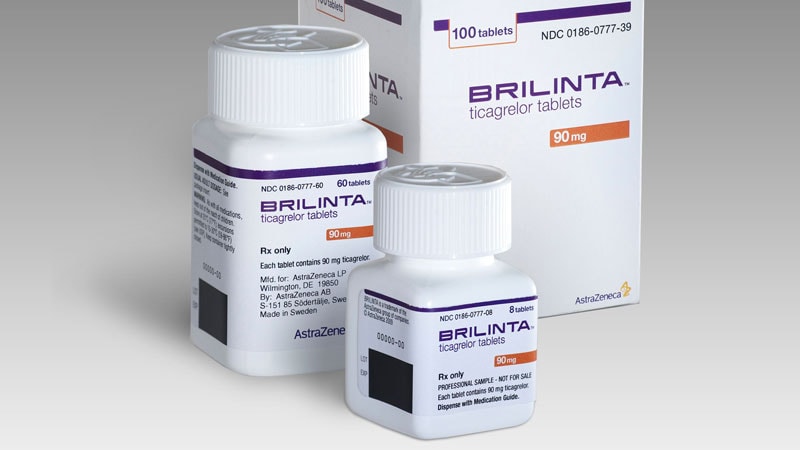Which Antiplatelet Agent for Patients With TIA and Obesity?
Compared with clopidogrel plus acetylsalicylic acid (ASA), ticagrelor plus ASA is associated with a lower risk for recurrent stroke in patients with obesity who carry the CYP2C19 loss-of-functional allele, new research suggests.
In a secondary analysis of the multicenter randomized controlled CHANCE-2 trial (Ticagrelor or Clopidogrel With Aspirin in High-Risk Patients with Acute Nondisabling Cerebrovascular Events II), ticagrelor plus ASA was associated with a 49% lower rate of stroke within 90 days among patients with obesity, compared with clopidogrel plus ASA.
However, investigators found no difference in benefit between the two antiplatelet regimens in nonobese patients. Rates of severe or moderate bleeding were similar between the BMI groups.
The study was published online July 10 in the Canadian Medical Association Journal.
BMI Matters
In CHANCE-2, stroke risk was reduced overall with ticagrelor plus ASA, compared with clopidogrel plus ASA, in patients with minor ischemic stroke or transient ischemic attack (TIA) who carried the CYP2C19 loss-of-function allele. For the current study, Xingquan Zhao, MD, chief physician and professor of neurology at Beijing Tiantan Hospital in China, and colleagues investigated the influence of BMI on the efficacy and safety of the two regimens in this population, given that previous work had suggested that BMI may affect the response to platelet P2Y12 receptor inhibitors.
Among 6412 patients enrolled in CHANCE-2, the median age was 64.8 years. About 34% of patients were women, and 98% were of Han ethnicity. In addition, 876 (13.7%) were obese (BMI ≥ 28 kg/m2).
Ticagrelor plus ASA was associated with a significantly lower rate of stroke within 90 days among patients with obesity (5.4% vs 11.3%; hazard ratio [HR], 0.51), but not among patients in the nonobese group (6.0% vs 7.0%; HR, 0.84).
When modeling BMI as a continuous variable, each 5-unit increase in BMI was associated with an 18.0% decrease in the HR of 90-day stroke in favor of ticagrelor plus ASA.
Similar results were found for the secondary efficacy outcomes of ischemic stroke, vascular events within 90 days, and ordinal stroke or TIA within 90 days.
For ticagrelor plus ASA versus clopidogrel plus ASA, BMI was not associated with rates of severe or moderate bleeding in the obese group (0% vs 0.2%) or nonobese group (0.3% vs 0.4%).
After 90 days of treatment with the study drugs, secondary prevention drugs (eg, lipid-lowering or antihypertensive drugs) were prescribed with similar frequency in the clopidogrel and ticagrelor groups for participants with or without obesity.
“BMI influences the efficacy of ticagrelor–ASA versus clopidogrel–ASA among patients with minor ischemic stroke or TIA who carry a CYP2C19 loss-of-function allele,” write the authors. “Clopidogrel appears to lose its efficacy among patients with obesity. Patients with obesity appear to derive clinical benefit from ticagrelor–ASA therapy without increasing risk of moderate or severe bleeding after minor ischemic stroke or TIA.”
“A New Era”

Dr Gregory A. Maniatis
Commenting on the study for Medscape Medical News, Gregory A. Maniatis, MD, director of structural heart disease at Northwell Staten Island University Hospital in New York City, said: “The best combination of antiplatelet agents for a given patient is an issue that cardiologists deal with regularly.” He added that the authors’ conclusions “seem valid for the population studied in the article.” Maniatis was not involved in the current study.
“More broadly and excitingly,” he noted, “the study highlights that we are entering a new era in medicine, marked by more targeted pharmacotherapy based on modifiable and gene-specific patient characteristics.”
That said, with a secondary analysis of a randomized controlled trial, “there is an increased risk of type I error [ie, false positive], and thus, the need for a greater sample size or setting a lower significance level to ensure statistical meaningfulness.
“In the United States, we treat a more diverse population and do not typically incorporate genotype testing prior to initiating antiplatelet therapy,” said Maniatis. “The generalizability of this study to a typical cardiology practice in the United States is thus not certain.”
A study that includes a more diverse population and longer-term follow-up would be desirable, he added. “In this study, the greatest benefit of ticagrelor–aspirin, compared to clopidogrel–aspirin, appeared to occur within the first 30 days of treatment, although the curves seem to continually diverge.
“The difference in outcomes beyond 90 days is important, as our goal is lifetime risk reduction of stroke,” he added. “Furthermore, the bleeding risk of antiplatelet therapy increases with time; thus, the difference in bleeding events with ticagrelor–aspirin versus clopidogrel–aspirin beyond 90 days is important to define.”
The study was supported by the Chinese Academy of Medical Sciences Innovation Fund for Medical Sciences, the National Key Research and Development Program of China, the Training Fund for Open Projects at Clinical Institutes and Departments of Capital Medical University, the Beijing Natural Science Foundation Haidian Original Innovation Joint Fund, and the Fund for Young Talents of Beijing Medical Management Center. The study authors and Maniatis r have reported no relevant financial relationships.
CMAJ. Published online July 10, 2023. Full text
Follow Marilynn Larkin on Twitter: @MarilynnL
For more news, follow Medscape on Facebook, Twitter, Instagram, YouTube, and LinkedIn.
Source: Read Full Article
